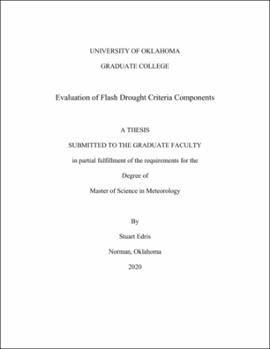| dc.description.abstract | Flash droughts occur rapidly (approximately 1 month timescale) and have produced significant ecological, agricultural, and socioeconomical impacts. Recent advances in our understanding of flash droughts have resulted in methods to identify and quantify flash drought events. However, little work has been done to isolate the individual flash (or rapid intensification) and drought components of flash drought, which could further determine their cause, evolution, and predictability. As such, this study utilized a flash drought identification method developed by Christian et al. (2019) to quantify individual components of flash drought through 1979 – 2019, using evapotranspiration (ET) and potential evapotranspiration (PET) data from the North American Regional Reanalysis Model (NARR). Flash droughts were identified using the standardized evaporative stress ratio (SESR), which uses four criteria to identify flash droughts: (1) the flash drought lasts at least 30 days, (2) SESR is below the 20th percentile at the end of the rapid intensification, (3) standardized changes in SESR on the pentad timescale is below the 40th percentile, and (4) the mean standardized change in SESR for the entire flash drought is below the 25th percentile. Because the first, third, and fourth criteria involve checks for rapid drying or rapid intensification of drought they are used to represent the rapid intensification or “flash” component of flash drought. The drought component (represented by criteria 2) was assessed using the U.S. Drought Monitor for 2010 – 2019 and individual case studies were examined, and the flash component was assessed using results of previous flash drought studies. In addition, the correlation coefficient and composite mean difference was calculated between the flash component and flash droughts identified to determine what regions, if any, experienced rapid intensification but did not fall into flash drought. The results yielded that SESR was able to represent the spatial coverage of drought well for regions east of the Rocky Mountains, with mixed success regarding the intensity of the drought events. The flash component tended to agree well with other flash drought studies, though it is more challenging to verify as no other measure of rapid drying is available for cross validation. Further, the overall climatology of the flash component showed similar hotspots to the flash drought climatology east of the Rocky Mountains, but also suggested areas west of the Rocky Mountains experience rapid intensification at high frequencies. | en_US |
